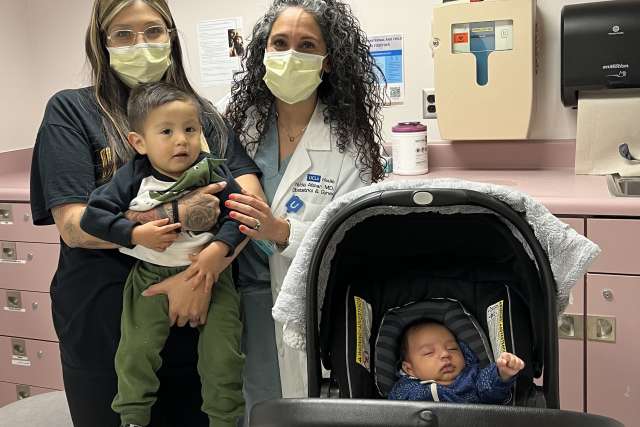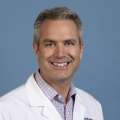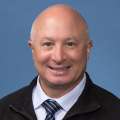Growing up, Nancy Mendez was keenly aware that she had a heart condition. In elementary school, she’d tire easily and sometimes struggled to breathe when she did physical activities. By middle school, it was worse: although she’d be assigned to run four laps during P.E. rather than six, she struggled to complete them. “My lips would get purple, my nails would be purple,” she said. “It would bum me out a lot, because I always wanted to play sports growing up, but I couldn’t because of my condition.”
Even worse were the regular cardiology check-ups. As she entered puberty, she became increasingly self-conscious about the exams, which required her to undress from the waist up. So, when she turned 18, she simply stopped going. It was easier to try to ignore her heart issues, and for several years, she did just that.
“I started getting to the age when I just wanted to have fun and party,” Mendez said. But there were still times she struggled to breathe, still times her lips and her fingers would turn purple due to lack of oxygenation. For a time, there was drug and alcohol use too, which placed further strains on her heart. And, she acknowledges, she was “hanging around the wrong crowd.” That landed her in jail for a few months when she was 21.
When she got out, she decided to do better.
But it wasn’t until Mendez got pregnant, at 24, that she first visited UCLA Health and started coming to terms with her heart condition.
The stress test of pregnancy
In 2013, when Mendez was 17 weeks pregnant, the strain of pregnancy on her already compromised heart landed her in the hospital. Along with shortness of breath, Mendez was again showing telltale signs of oxygen depletion, including bluish lips and fingers.
“Pregnancy is a natural stress test,” explained , co-director of the UCLA cardio obstetrics program, who’s treated Mendez during her three subsequent pregnancies.
“There are some normal physiologic changes that occur in every pregnancy, and that includes increasing the total blood volume and dropping the blood pressure,” said Dr. Afshar, professor of obstetrics and gynecology in the division of maternal fetal medicine at the . “Even by six weeks of pregnancy, you have a 50% increase in your cardiac output. And those changes, for someone with underlying congenital heart disease, are significantly different.”
In Mendez’s case, “her oxygen saturation had dropped pretty significantly,” explained , who specializes in adult congenital heart disease and pediatric cardiology and has treated Mendez ever since her first pregnancy.
That meant her baby was being deprived of oxygen. The team opted to intervene, using a cardiac catheter to place a device that closed the hole between the two upper chambers of her heart that was causing oxygen-poor blood to be pumped through her body.
Mendez’s heart condition, Ebstein’s anomaly, also meant that the valve leaflets, or flaps, on the right side of her heart weren’t functioning correctly, resulting in a very leaky valve, Dr. Reardon said. It was a difficult balancing act to optimize Nancy’s circulatory system and ensure that her baby got all the necessary nutrients, given that the typical intervention to repair or replace the valve using open-heart surgery simply wasn’t feasible while Mendez was pregnant, he explained.
For the rest of her pregnancy, Mendez was seen regularly by UCLA Health’s high-risk obstetricians and the adult congenital heart disease team, and her baby was also monitored by , co-director of the health system’s Fetal Cardiology Program, given the increased chance of her baby also having congenital heart disease.
During Mendez’s hospitalization at 17 weeks, Dr. Satou diagnosed the developing fetus with several congenital heart defects, including holes between the chambers of the heart. Although they didn’t require immediate treatment, they would need to be fixed during the first year or two of life, explained Dr. Satou, professor of pediatrics at the David Geffen School of Medicine.
Surgeries on mother and son
Not long after her son Oscar was born, Mendez got to the point where she was “having a very hard time getting through the day,” she said. There were days when she would feel like she couldn’t breathe; even walking half a block felt overwhelming.
“One of the things that most people don’t realize is that many congenital heart disease patients can often tolerate pregnancy with careful management, but then new symptoms or issues can be magnified after delivery,” Dr. Reardon said.
In Mendez’s case, Ebstein’s anomaly meant that the tricuspid valve (located between the two right chambers) didn’t develop properly, which affected the entire right side of her heart and caused abnormal blood flow, Dr. Reardon explained. Now, it had finally gotten to the point where she needed open-heart surgery to replace the valve and restore proper blood flow.
Mendez underwent the surgery in 2014. “We appreciate that caring for a newborn and having open-heat surgery is a monumental feat,” Dr. Reardon said.
About six months later, just shy of his second birthday, Oscar also underwent open-heart surgery. His heart was dilating from the increased blood flow due to the holes between the chambers, Dr. Satou explained, and he was experiencing increased pressure on his lungs as a result.
The surgery included closing the two holes in his heart: one between the two upper chambers, called an atrial septal defect, and one between the two lower chambers, called a ventricular septal defect. Oscar also had an extra artery that had remained open rather than closing on its own after birth, so that was sealed off too.
In Oscar’s case, other than heart medicine to treat a fast heart rate (a condition known as atrial flutter), he’s had no further interventions. He continues to be seen annually, but most likely won’t require any further surgeries, Dr. Satou said.
The turning point
For Mendez, though, the road to health was a longer one. She and her partner had separated when Oscar was 7 months old, and she was struggling with the aftermath. “It was very hard for me to process being a single mother,” she said.
She leaned on her parents for support, but also started turning back to her old life, she acknowledged, which meant partying and alcohol use. Mindful of the risks of mixing alcohol with her ongoing heart medications, Mendez simply stopped taking them.
The new tricuspid valve started to leak, placing additional strain on her heart. Even in a perfect scenario, a surgical valve lasts just five to 10 years, Dr. Reardon explained. In Mendez’s case, a leak developed on the outside edge of the valve that required a cardiac catheterization via a blood vessel in her groin to plug the new area of leakage.
That, Mendez recalls, was the turning point. “It wasn’t just me anymore,” she said. “I realized I had to take care of myself for my son. And that’s when I started doing everything right.”
A unique bond
Dr. Reardon, who continues to see Mendez as a patient, has firsthand knowledge of what it’s like to live with congenital heart disease. When he was 5, he underwent open-heart surgery to correct a pulmonary valve stenosis: a too-narrow valve leading from the right ventricle of the heart to the lungs.
It’s something many of his heart patients, including Mendez, know about, he said. “It sort of engenders trust,” he said, adding that one teenage patient told him it gave him “street cred.”
Dr. Reardon’s personal story also means that he understands the chest pain patients with congenital heart disease sometimes experience as a result of open-heart surgery, he added. Plus, the message about living healthier “also might just be a little bit more impactful,” he said.
A team approach
Mendez has had three more sons since Oscar, all under the care of UCLA Health’s high-risk obstetrics team. Even with the interventions she’s had, pregnancy is still considered high risk for Mendez because of her congenital heart disease, Dr. Afshar explained.

It’s a risk that’s surmountable with a team approach, though. The goal is “to optimize Nancy’s health to get her through the pregnancy,” she said. “We have a delivery plan that we’re continuously revisiting with her every time, (including) how she and the baby are doing with each pregnancy. It’s all about both of us being on the same page and communicating regularly.”
Nancy is “a central piece of that cardio OB team,” Dr. Afshar added.
Given her underlying cardiac disease, the three biggest risks Mendez has faced during her pregnancies are blood clots, arrhythmia (abnormal heart rhythm) or heart failure, Dr. Afshar explained.
Each time, Mendez’s medication regimen had to be altered so she could continue to take the medicines her heart requires but do so in a way that’s safe during pregnancy. Because the blood thinner Mendez normally takes isn’t safe for the developing fetus, she has had to switch to a different medication each time, requiring daily injections throughout each pregnancy and while she’s breastfeeding.
The blood thinner also had to be discontinued entirely each time Mendez was in labor, which meant extra vigilance to ensure she didn’t develop a blood clot, Dr. Afshar said.
Throughout each pregnancy, the developing fetus also had to be regularly monitored, due to the increased risk of miscarriage and of delivering early and/or having a smaller baby.
Each time, though, Mendez has sailed through.
“Despite having really complex congenital heart disease,” Dr. Reardon said, “and despite having to deal with giving herself daily injections to protect her valves, she surprised us all and just flew through these pregnancies without any problem.”
Although Mendez’s condition increases the risk of her children having congenital heart disease, “the numbers aren’t as scary as I think people imagine them to be,” Dr. Reardon said. The risk is about 1% for the general population, he said, but when the mother has congenital heart disease, the risk for the baby increases to somewhere between 5% and 8%.
Mendez’s two middle sons don’t have any cardiac issues. Her youngest son, Adam, born at UCLA Health in March, has a small hole between the upper two chambers of his heart, said Dr. Satou, but it’s “a trivial heart problem unlikely to need intervention.”
A long-term relationship
Being able to treat both a mom and a baby with congestive heart disease at the same location is a unique advantage that UCLA Health offers, Dr. Reardon said.
Since Mendez’s open-heart surgery and subsequent valve repair, she’s had a valve replacement (also done via the blood vessel in her groin). She continues to be seen every six months by Dr. Reardon. “Her long-term prognosis is very good,” he said. “I expect her to live a long, healthy life.”
While he expects she’ll need additional procedures, “my job and her job is to help those valves stay as healthy as they can for as long as they can.”
As Mendez’s sons continue to grow, UCLA Health will be along for the journey. Adam will continue to be monitored as he grows. Her oldest son, Oscar, also continues to be seen annually by Dr. Satou; once he’s an adult, he’ll shift to Dr. Reardon or another member of the UCLA Health team that takes care of his mother.
With patients like Mendez, Dr. Reardon said, “It’s really nice to feel like you’re in it with them for the long haul. Nancy and I have been through so much together that we’re definitely bonded that way.”
Lisa L. Lewis is the author of this article.






